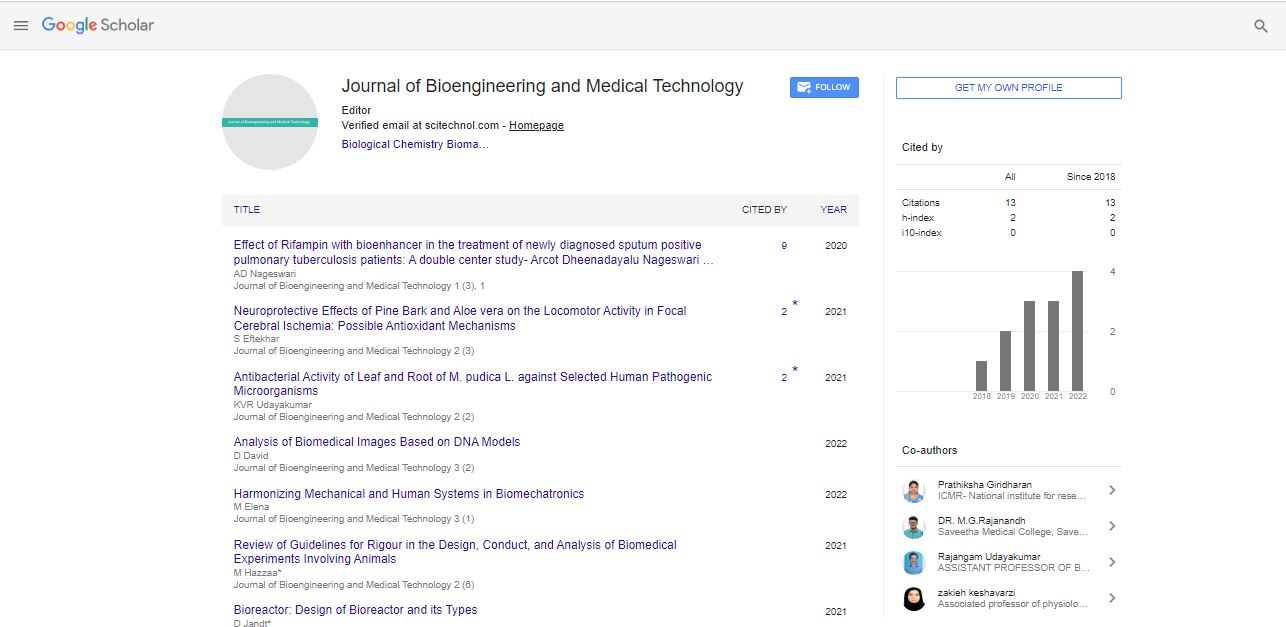Opinion Article, J Bioeng Med Technol Vol: 3 Issue: 3
Repeated Application of Riboflavin during Corneal Cross-Linking
Louis Vitalis*
Department of Bioengineering, University of Life Sciences, Lausanne, Switzerland
*Corresponding Author: Louis Vitalis
Department of Bioengineering, University of Life Sciences, Lausanne, Switzerland
Email: vitalis48@gmail.com
Received date: 13 April, 2022; Manuscript No. JBMT-22-77875;
Editor assigned date: 15 April, 2022; PreQC No. JBMT-22-77875 (PQ);
Reviewed date: 26 April, 2022; QC No. JBMT-22-77875;
Revised date: 06 May, 2022; Manuscript No. JBMT-22-77875 (R);
Published date: 16 May, 2022; DOI: 10.4172/Jbmt.1000061
Citation: Vitalis L (2022) Repeated Application of Riboflavin during Corneal Cross-Linking. J Bioeng Med Technol 3:3.
Keywords: Biomechanics
Description
Virtual Reality Technologies (VRT) considers an individual to encounter the visual and hear-able vibes of a climate from the solace and security of a facility or their own home. Because of diminishing expenses, VRT have turned into a quickly developing worldview as an assistive innovation and interventional technique for people with mental imbalance and different incapacities. VRT is a lengthy term with various fundamental advances, for example, virtual climate reproductions. VR is a type of head-mounted show that modified programming that represents virtual conditions for cooperative virtual association and vivid virtual conditions. The parts of which incorporate 3D designs, symbols, independent controls, and 2-way input/yield ports. VR can give a practical recreation of this present reality that can be utilized for different remedial purposes. Augmented reality can be utilized by specialists and teachers to give a protected climate to treatment of a wide range of inabilities and issues, for example, consideration attention deficit hyperactivity disorder, discouragement, bipolar turmoil. By fusing VR into treatment with kids on the chemical imbalance range, a few of the obstructions of showing abilities in the regular habitat can be survived. Conduct treatment requires rehashed practice of abilities. When in-situ preparing is expected for speculation, this implies that the clinician, client, and guardian should be accessible to go to local area areas to show abilities on various events. Booking these sorts of excursions can be troublesome particularly in single parent families where the two guardians work all day. There are additionally wellbeing worries with these kinds of trips. In these uncontrolled conditions the client is presented to assortment of possible dangers, especially while mastering security abilities like going across the road. There are likewise strategic issues with in-situ preparing. Oftentimes the clinician doesn't approach the climate where the conduct should be instructed/rehearsed. With some health care coverage, for instance, the clinician is banned from utilizing protection subsidized treatment time in everyday schedule of school sitting? VR might defeat these boundaries by permitting the client to rehearse in a virtual climate almost indistinguishable from the nature. What it implies is the client who doesn't have to go external the school with VR. The utility of this innovation is evaluated in how well abilities mastered in the counterfeit climate sum up to the regular habitat. While this exploration is restricted, there offers guarantee for future examinations and applications. A few investigations have exhibited the utility of VR in mental imbalance treatment. Abilities like going across the road, starting a discussion, tracking down a seat, strolling out in the open, requesting food, and answering disastrous circumstances have been shown utilizing VR previously, a portion of the worries with VRT have been movement infection and awkward headsets. The member was strolled to the lab went with the specialist to begin a planned 30- minute meeting. Meetings began as arranged in light of the period of the review. The review was directed in stages (initial meeting, gauge in the indigenous habitat, VR benchmark in the virtual climate, VR intercession, and speculation in the indigenous habitat). Student Undetectable glasses were utilized uniquely during the regular habitat gauge and speculation test meeting. Though VR-3 were utilized during the VR benchmark and VR mediation stages. During all phases of the review, eye following information were gathered for unbiased and useful advantages. A concurrent multiple baselines across members configuration was used. Reactions were physically gathered by the specialists while VRT gathered eye following information.
Individualized Technique for Navigation and Ceaseless
The two information types gathered by the innovation devices and advisors were thought about and correlated in this review. The upsides of eye-following information in both the glasses and VR headset were seen to decide how VRT can illuminate advisors and increment the legitimacy of the program result by confirming the outcome with the objectivity of eye-following estimation. Furthermore, decreasing the span of mediation because of the educated and individualized technique for navigation and ceaseless individualized change of guidelines. The initial meeting included building affinity with possible members by presenting the specialist's name and getting some information about his/her name and age. Then the specialist occupied with little discussions with the member and introduced a few toys. A meeting of the members was led to decide whether the members fit the measures to partake which were the capacity to adhere to explicit and basic directions, for example, look right, look left, look into, peer down, go ahead, move in reverse, and bring thing. In addition, confirming the ability of client to identify pictures of grocery items in an array of 3, the ability to complete the calibration process in four different directions. If the participants were unable to discriminate between potential items and distractors, therapists trained them using Discrete Trial Teaching (DTT). After that, the therapist familiarized the participants with the VR headset by playing games. The physical requirements of the inclusion criteria were considering the tolerance of wearing the headset. A minimum weight of 40 kilograms and height of 120 centimeters were required in recruiting participants. Once it was confirmed participants met the criteria, they were scheduled for a baseline session. Natural Environment Base lined (NEB) was conducted in a local grocery store, where participants wore pupil invisible to record their eye gaze. When delivering the instruction to find a specific item, the client was standing at the end of the aisle. Specific items were chosen randomly for each client from the list of items confirmed to be in both the VR environment and the local grocery store. Data collected based on specific steps that were determined in the task analysis see chart. The video with eye gaze tracking was used to collect data. Virtual Reality Baseline (VRB) session conducted to each participant to identify participants’ skills level in the virtual environment. Participant asked to wear the VR headset then therapist deliver the Discriminative Stimulus (SD) to find a specific item from the virtual grocery store aisle independently. Data from the VRB and NEB was used to identify which task analysis’ step(s) were not in the participant’s repertoire. The Virtual Reality Intervention (VRI) training sessions took place at Centre for Autism Research (CFAR).
Prompt levels determined based on a probe conducted for each participant. A prompt delay used during the intervention to provide opportunities for independent responses. The Lead Therapists (LT) delivered Discriminative Stimulus (SD) and provided prompt as needed. The Assistant Therapists (AT) stood in front of the Personal Computer (PC) screen monitoring participant eye gaze to provide gesture prompts through the pointer as needed. The LT provided physical prompt as needed based on the AT’s feedback. Before delivering the SD, the LT reminded the participants about the following instructions: look right, look left, look up and down. Praise was provided contingent upon correct responses. The intervention contained a 9-step task analysis used for data collection. If the participant independently performs the step, it was recorded as correct, while prompted responses were considered incorrect. Sessions lasted 30 minutes with a break given to participants halfway through. During the GP, all participants got 100% of responses correct. With MM in the NEB condition, the correct responses started at 75% then decreased to 25%. During VRI condition, correct responses increased until they reached the criterion in the third trail. With correct responses increased then decreased during VRI, correct responses increased, and then the data stabled for two sessions at 80% then increased again to reach the criterion in the fourth session. With the data show a decrease in the trend to a low level 25%. Correct responses accelerated during the VRI until reaching the mastery criteria in the third trail and maintaining. Data points were unstable during therefore VRI was delayed for this participant until baseline became stable. At the beginning of the training the data points were unstable until the fourth trail, and then the participant reached 100% of correct responses and remained consistent.
 Spanish
Spanish  Chinese
Chinese  Russian
Russian  German
German  French
French  Japanese
Japanese  Portuguese
Portuguese  Hindi
Hindi 
